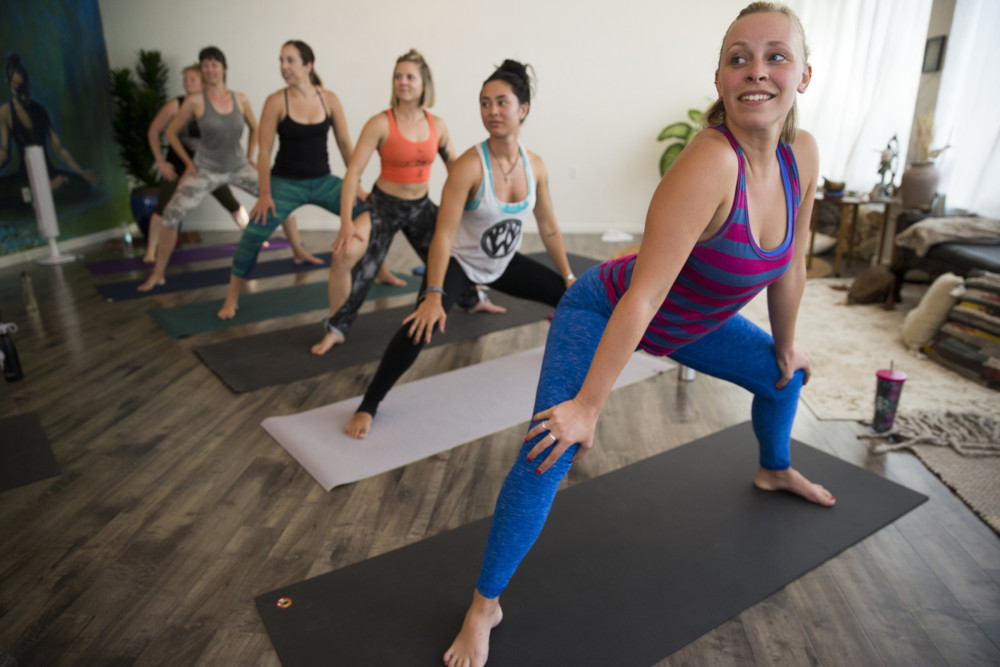By William Robert Ferrer
The Seattle Times
WWR Article Summary (tl;dr) “Trap yoga” takes the traditionally tranquil and meditative practice of Yoga and marries it with gritty “trap” music.
SEATTLE
On the speakers, Future rapped about Molly, Percocet and Hendrix, and on the floor, I concentrated on trying to coerce my hips into something resembling a twerk.
No dice.
This wasn’t a frat party or another ill-advised night barhopping on Capitol Hill, but a trap-yoga class.
Trap yoga takes the traditionally tranquil and meditative practice and marries it with gritty trap music, a genre of hip-hop defined by its use of the Roland TR-808 drum machine (think: T.I. or Gucci Mane).
It might seem like an unusual pairing, but trap yoga is having something of a moment.
In 2014, Chicago yogi Asia Nichole Jones trademarked the term “trap yoga” and, since then, practices and one-off events have cropped up in San Francisco, Los Angeles, Milwaukee and other major cities.
Seattle instructor Abiola Akanni, 29, has been teaching her version of trap yoga, dubbed Trap Vinyasa, for two years and practicing for three.
Akanni said she hadn’t heard of others leading trap yoga classes until after she began regularly offering Trap Vinyasa.
Recently, I met Akanni at Bohemian Studios in Phinney Ridge for her Trap Vinyasa class. (She’s also an instructor at 8 Limbs Yoga.)
I took, and almost failed, a power-yoga class in college, and beyond that I’ve had little experience folding my body into a pretzel, regulating my breathing and using my chicken arms to support my body weight.
I prefer jogging.
Akanni said her class embraces beginners. “Trap Vinyasa just invites so much self-exploration,” she said. “But it meets you exactly where you’re at. It doesn’t require you to have yoga practice established yet.”
Often, trap yoga is credited with helping to break down barriers to the practice, especially among communities of color.
Brandon Copeland, a Washington, D.C.-based yogi featured in a recent The Fader magazine story, talked to me on the phone recently about trap yoga.
Copeland began his practice in part because he was concerned that traditional studios weren’t reaching enough people. “I wanted to see young, black people doing yoga. And that wasn’t a thing as of a couple of years ago,” he said. “There wasn’t really a lane that was carved out.”
Akanni seemed to agree that yoga could do more to increase the number of diverse students on mats. “Yoga practice can be really intimidating,” she said. People of color don’t “really feel encouraged. You don’t feel encouraged to go into those spaces.”
While this particular class in Phinney Ridge didn’t draw a super diverse crowd, Akanni said that’s not usually the case.
“Our typical class is probably, I want to say 80 percent POC, the ones that we host bimonthly at Washington Hall,” Akanni said.
The class I attended was part of her studio tour, she explained, and those classes often cater to a studio’s pre-existing clientele.
A BODY-POSITIVE EXPERIENCE
Once everyone was in place on their mats, Drake’s voice was replaced by Akanni’s booming and hypnotic commands.
She instructed us to grab a part of our bodies we dislike (see: the aforementioned chicken arms) and concentrate our energies on it. For Akanni, self-love is a vital part of Trap Vinyasa.
“It’s just a body positive experience in a world that shames us about our bodies,” Akanni said.
Eventually, the relative silence of the class was punctured by a trap beat. A series of traditional poses followed: Table top. Downward dog. Warrior one. Warrior two.
And then came the twerking.
Despite my fear of looking like a kid with no rhythm and my limited range of pelvic motion, it was a refreshing reprieve from the standard self-seriousness of yoga.
Shouting out positive affirmations like “You go, girl!” or “I see you, Will!” (Sage the Gemini’s “Gas Pedal” came on, and I’m always down to move to “Gas Pedal”), Akanni also has a knack for dispelling your doubts and making you feel like you, and your body, belong in her space.
And so I moved my butt, arms and torso to the music with a lack of self-consciousness I usually achieve only after three Long Island Iced Teas in a dimly lit room.
“People find the booty shake liberating,” Akanni said.
After that first, virginal twerk, the rest of the class became something like an elaborately choreographed dance routine.
As the class bent into a forward fold, Akanni told us to shimmy through the movement and, as we moved from a low plank to a downward dog, she urged us to engage our hips (“Now bring it back, bring it back, bring it back,” Akanni cheered to the rhythm).
Sometimes, Akanni invited us to freestyle. Other times, I got caught up in the verve of the class and found myself moving of my own accord like, “Oh, did you want us to stop gyrating?”
By the end of class, my cool-guy T-shirt was dripping with sweat.
“I loved it. It felt liberating,” said Erin McIntire, 26. She said she was drawn to Trap Vinyasa after hearing that the course was taught by a black yogi.
“I feel like this is the kind of thing we need to see more of,” McIntire said.














































































































































































































































































































































































